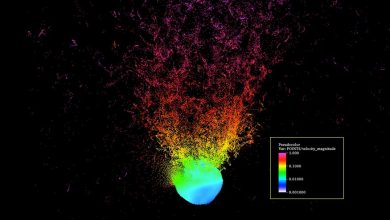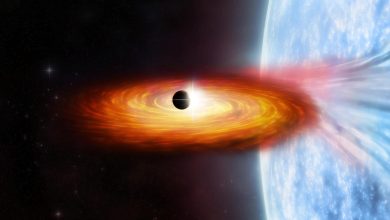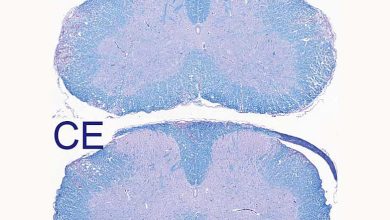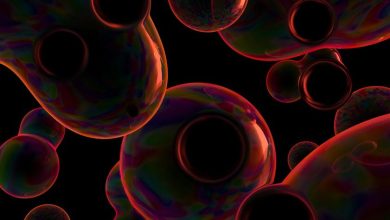Latest Articles
-
Oct- 2021 -27 OctoberSpace - Asteroids

Planetary Defense: Nuclear Explosion Can Disrupt Hazardous Asteroid To Protect the Earth
Lead Image: The hydro simulation in Spheral that provided the basis for the analysis: 1 Megaton at a few meters standoff distance from a 100-meter diameter asteroid (with Bennu shape). Colors denote velocities. The legend is cm/us, which is equivalent to 10 km/s. Credit: LLNL If an asteroid is determined to be on an Earth-impacting trajectory, scientists typically want to stage a deflection, where the asteroid is gently nudged by a relatively small change in velocity, while keeping the bulk of the asteroid together. A kinetic impactor or a standoff nuclear explosion can achieve a deflection. However, if the warning…
Read More » -
26 OctoberNASA

First Evidence for a Possible Planet Outside of the Milky Way Galaxy
Lead Image: Astronomers have found evidence for a possible planet candidate in the M51 (“Whirlpool”) galaxy, representing what could be the first planet detected outside of the Milky Way. Chandra detected the temporary dimming of X-rays from a system where a massive star is in orbit around a neutron star or black hole (shown in the artist’s illustration). This dimming is interpreted as being a planet that passed in front of an X-ray source around the neutron star or black hole. Credit: NASA/CXC/M. Weiss Astronomers have announced evidence for a possible planet in another galaxy. This “exoplanet” would be…
Read More » -
23 OctoberScience

Einstein-Developed Treatment Strategy May Lead To Cure for HIV and Other Chronic Viral Infections
Proteins designed to focus immune attack on HIV-infected cells. Armed with a novel strategy they developed for bolstering the body’s immune response, scientists at Albert Einstein College of Medicine have successfully suppressed HIV infections in mice—offering a path to a functional cure for HIV and other chronic viral infections. Their findings were published on October 21, 2021, in the Journal of Clinical Investigation. The research involved proteins designed to selectively stimulate the immune system’s CD8+ “killer” T cells to multiply and specifically attack HIV-infected T cells. Co-corresponding author Steven Almo, Ph.D., developed the synthetic proteins, known as synTac (short for…
Read More » -
22 OctoberScience

Fighting Multiple Sclerosis With Cold, Depriving the Immune System of Its Energy
Lead image: Demyelinated spinal cord of mice suffering from autoimmune disease. Top, at room temperature, and bottom, exposed to cold. Myelin is colored in blue. The purple staining within the white matter (parts towards the edge of the histological section) shows demyelinated lesions that are reduced in the bottom image. Credit: © UNIGE – Laboratoires Trajkovski & Merkler /Cell Metabolism Scientists at UNIGE are demonstrating how cold could alleviate the symptoms of multiple sclerosis by depriving the immune system of its energy. In evolutionary biology, the “Life History Theory,” first proposed in the 1950s, postulates that when the environment is…
Read More » -
21 OctoberSpace

Uncovering the Secrets of Ultra-Low Frequency Gravitational Waves and the Early Development of Our Universe
Lead image: An artist’s impression of the colliding bubbles that can produce extremely low frequency gravitational waves during a cosmological phase transition in the early Universe. Credit: Riccardo Buscicchio New methods of detecting ultra-low frequency gravitational waves can be combined with other, less sensitive measurements to deliver fresh insights into the early development of our universe, according to researchers at the University of Birmingham. Gravitational waves — ripples in the fabric of Einstein’s spacetime — that cross the universe at the speed of light have all sorts of wavelengths, or frequencies. Scientists have not yet managed to detect gravitational waves…
Read More »










